Israeli State of the Birds Report
The State of the Breeding Birds in Israel
An analysis based on the data from the recently updated Red List of Breeding Birds in Israel (2017).
Trends in the Numbers of Bird Species Classified as Endangered
As part of the update of the Red List of Breeding Birds in Israel, 213 breeding bird species were examined. Of these, 14 species are believed to be regionally extinct and 65 species were assessed as threatened with extinction (Figure 1). Following the assessment, they were divided into the following categories:
Regionally Extinct: Species that no longer breed in the region, although some can still be observed as passage migrants, wintering or accidentals.
Threatened Species: Species that were assessed as Endangered (Figure 1, complete list in the appendices). These species were divided into three categories according to the probability of becoming extinct in the coming decades (CR – Critically Endangered, EN – Endangered, VU – Vulnerable to extinction).
The remaining species that were defined as less threatened according to IUCN criteria were divided into the following categories:
Least Concern: Species whose population or range has not decreased, or if it has, the decrease is below the threshold values determined. For example – the reduction in population size in the past 10 years or 3 generations (the longer of the two) is below 30%, as required by criterion A.
Near Threatened: Species whose populations or range has decreased significantly, but the decrease is below the threshold values specified by IUCN criteria (the conditions for inclusion in this category are specified in the introductory section).
Data Deficient: Species with inadequate information to make a direct or indirect assessment. In some cases, data maybe available but is still insufficient to address population or distribution trends.
Not Applicable: Species observed breeding in Israel, but which are considered invasive or naturalized in recent years; or species breeding in Israel sporadically whose population changes cannot be assessed. An additional 28 species are globally endangered species observed in Israel as passage migrants, wintering or accidental species. These species were included in the list as globally endangered species but their regional threat status was not assessed.
| נכחדים באזורנו | Regionally Extinct | 14 |
| מינים בסיכון | Threatened species | 65 |
| לא בסיכון | Least Concern | 83 |
| קרוב לסיכון | Near Threatened | 26 |
| מידע חסר | Data Deficient | 8 |
| לא הוערך | Not Applicable | 45 |
Figure 1: Percentage of Israeli breeding species in each threat category
Extinct Species in Israel
Of the 14 species classified as extinct in the 2017 edition, three species are recent extinctions, i.e. have not been observed breeding in Israel during the past ten years or more (Savi's Warbler Locustella luscinioides, Bimaculated Lark Melanocorypha bimaculata and Pied Avocet Recurvirostra avosetta). However, four other species, which in the previous edition were considered extinct, have been recorded breeding in Israel in recent years and have therefore been down listed (Peregrine Falcon Falco peregrinus, Great Crested Grebe Podiceps cristatus, White-tailed Eagle Haliaeetus albicilla and White-headed Duck Oxyura leucocephala).
|
Species |
Scientific name |
Estimated year of extinction |
Risk assessment 2017 |
Risk assessment 2002 |
Change |
|---|---|---|---|---|---|
|
Grey Heron |
Ardea cinerea |
1965 |
RE |
RE |
Unchanged |
|
Black Kite |
Milvus migrans |
1995 |
RE |
RE |
Unchanged |
|
Marsh Harrier |
Circus aeruginosus |
1953 |
RE |
RE |
Unchanged |
|
Arabian Ostrich |
Struthio camelus syriacus |
1920 |
RE |
RE |
Unchanged |
|
Black Tern |
Chlidonias niger |
1956 |
RE |
RE |
Unchanged |
|
Black Vulture |
Aegypius monachus |
1864 |
RE |
RE |
Unchanged |
|
Lappet-faced Vulture |
Torgos tracheliotus |
1990 |
RE |
RE |
Unchanged |
|
Lesser Spotted Eagle |
Aquila pomarina |
1972 |
RE |
RE |
Unchanged |
|
Verreaux's Eagle |
Aquila verreauxii |
1971 |
RE |
RE |
Unchanged |
|
Bearded Vulture |
Gypaetus barbatus |
1982 |
RE |
RE |
Unchanged |
|
Brown Fish-owl |
Ketupa zeylonensis |
1975 |
RE |
RE |
Unchanged |
|
Savi's Warbler |
Locustella luscinioides |
2000 |
RE |
CR |
Decline |
|
Pied Avocet |
Recurvirostra avosetta |
2002 |
RE |
NT |
Decline |
|
Bimaculted Lark |
Melanocorypha bimaculata |
2000 |
RE |
CR |
Decline |
Savi’s Warbler Locustella luscinioides – an example for a recently extinct species
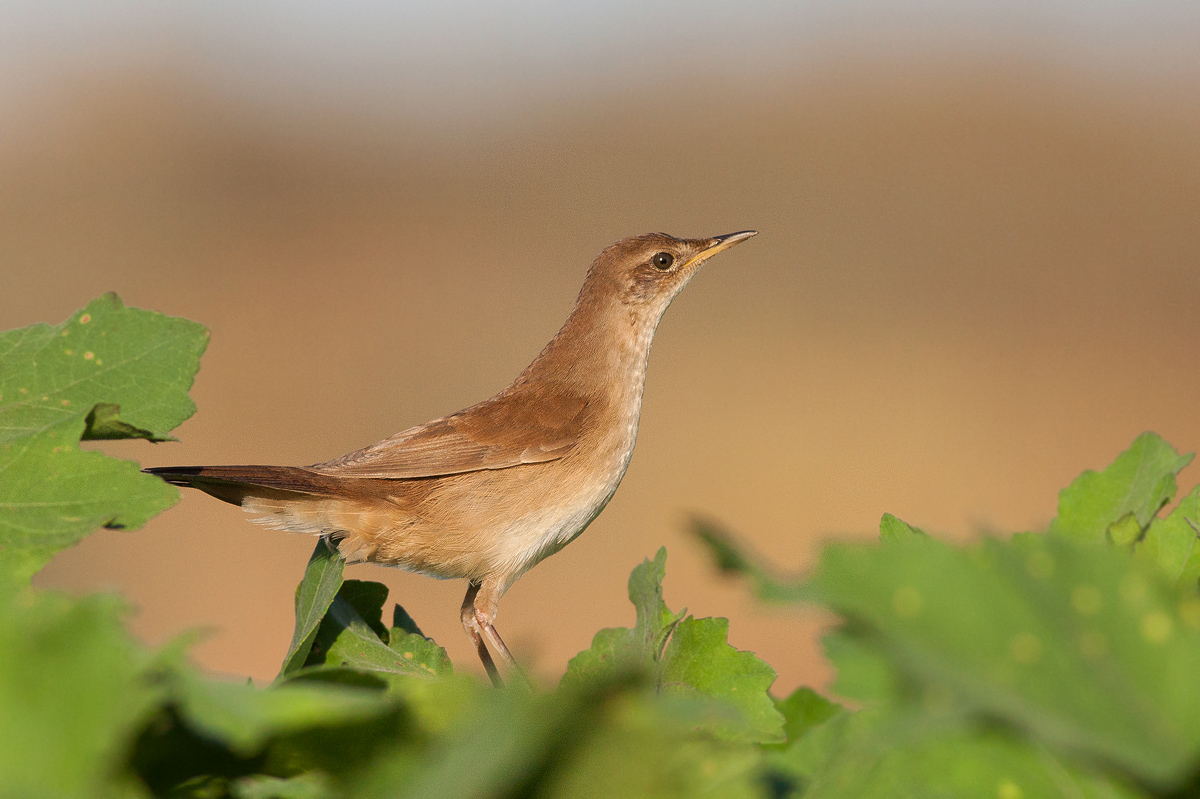
The dramatic decline of its population occurred over a very short period, between the late 1980s and the late 1990s. During this time, Savi’s Warbler went from being a relatively common breeding species found in almost all the water bodies surrounded by reed and tamarisk thickets, to an extremely rare and inconsistent breeder. During the past decade, there are no verified records of its breeding in Israel. Savi’s Warbler is known to exhibit strong inter-annual population fluctuations throughout most of its range. During recent years, it has been expanding its range in northern Europe, apparently due to global warming. The fact that Israel is its southern distribution limit, together with the decline in the quality of local water bodies have probably prevented its population from recovering from bad years. Savi’s Warbler, along with other species found in marsh thickets, such as the Moustached Warbler Acrocephalus melanopogon and the Great Reed-warbler Acrocephalus arundinaceus, which are critically endangered, is considered an indicator of the poor state of Israel’s wetlands.
White-tailed Eagle Haliaeetus albicilla – a species that has returned to breed
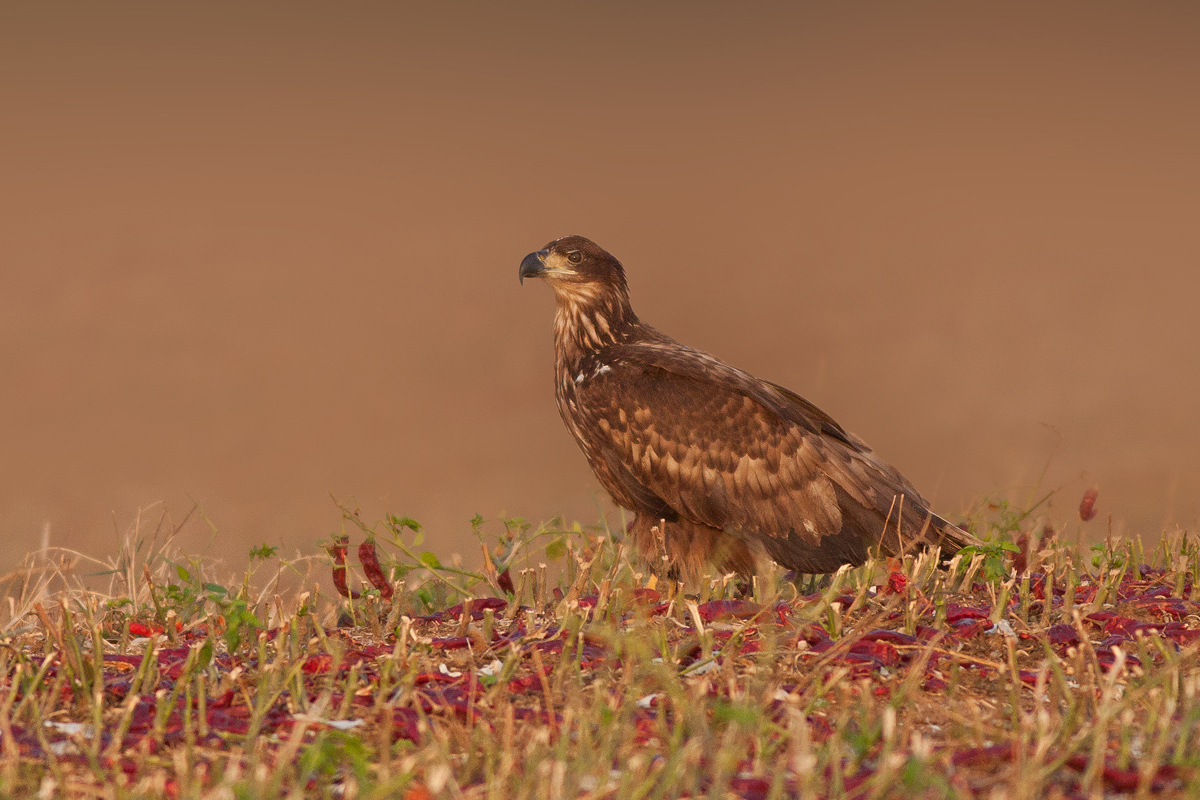
About 50 White-tailed Eagle chicks were released into nature over some 25 years of restoration efforts, before the first successful breeding was recorded. The restoration project began in 1990, with the establishment of the White-tailed Eagle captive breeding nucleus. Every year a number of fledglings hatched in captivity were released in the Hula, Bet Tsaida and Bet She’an valleys. The eaglets had to cope with a very different world since the last white-tailed eagle nest, on the slopes of Mt. Gilboa, was abandoned in 1957. Most of them were decimated during their first year as a result of electrocution, poisoned baits set out by farmers, or shooting or trapping by hunters from neighboring countries. In this manner, the White-tailed Eagles “provide information” about risk factors for birds of prey spending time in Israel. In 2015, the first White-tailed Eagle was fledged from a natural nest in the Hula Valley, after 60 years of absence. Since then one eaglet has fledged from the same nest every year.
Endangered Species in Israel
Since the previous version of the red book (Mayrose & Alon 2002), the number of endangered species has increased from 38 to 65. Of these, 57 species were up-listed and their current status is more severe, while the status of 43 other species has improved and the remainder have not changed or cannot be evaluated (figures 2 and 3).
On the other hand, some of the differences in species status assessment between the two editions result from the considerable differences in the quality of the available information and the assessment methods, and not necessarily from a real change in the status of the birds in Israel. When we neutralized[1] the effect of these artifacts, the picture changed significantly, and the status of 37 species was worsened and that of 21 species improved (the remaining species remained unchanged or the change could not be evaluated, Figure 4).
[1] The effect of differences in the standard of information and assessment methods was neutralized by analyzing risk assessments for species, while using data available when the previous edition was published, but with criteria defined for the current edition. In addition existing information regarding the status of species before 2002 was compared to data from 2002 until the present, and submitted to expert assessment to see if the differences in status justified changing the threat category.
Figure 2: A comparison of the number of species per threat category between the new and previous red lists.
Figure 3: Changes in the threat categories of species compared to the previous red list (2002 - 2017).
Figure 4: Estimation of the true changes in species status in relation to the previous red list (taking into account the differences in methodology and gaps in knowledge).
Data Deficient Bird Species
Eight species were categorized as DD in the following cases:
- The index of certainty of the species is below 0.7 (i.e. less than 70% of the grid cells in its range from 1990 received expert distribution and abundance evaluation).
- Species discovered breeding in Israel only during the past year or two, whose population trends are unknown (Pallid Scops Owl Otus brucei and European Nightjar Caprimulgus europaeus).
- One species (Rock Dove Columba livia) has been categorized as DD because the degree of hybridization with feral pigeons and the effect of this genetic mixing on the population is unknown.
The relatively small number of species categorized as DD does not reflect actual knowledge gaps, because the number of common species (e.g. House Sparrow Passer domesticus, Eurasian Blackbird Turdus merula, European Greenfinch Carduelis chloris, European Goldfinch Carduelis carduelis and others) have been categorized as LC based on generalized expert opinion, despite the fact that their certainty index is low. This emphasizes the need for standard breeding observation reports that contain useable and analyzable data (e.g. by using a standard terminology) and for expanding the number of birders reporting breeding data for common species (as opposed to general observation reports, that are not necessarily nesting observations).
The species categorized as DD are Pallid Scops Owl Otus brucei, Common Swift Apus apus, Alpine Swift Apus melba, European Nightjar Caprimulgus europaeus, Rock Sparrow Petronia petronia, Blackcap Sylvia atricapilla, Rock Dove Columba livia.
Factors Affecting the Survival and Sustainability of Israel's Wild Birds
We live in an age characterized by rapid and extreme habitat changes, on a global scale. Most of these changes are a consequence of the growth of human populations and the extensive resources they consume, and have a dramatic effect on the animal world. Habitats in which organisms developed for millions of years suddenly change within a few years, at a rate too rapid for the genetic and behavioral adaptations needed for survival. This situation causes entire populations to be pushed to the limits of their survival and sometimes beyond. Scientists term this age the “sixth extinction”, an age in which global biodiversity is declining at an ever increasing rate.
Whereas the general cause (i.e. the growth of human population) is clear and known, the immediate cause or mechanism that affects specific animals is not always obvious. Some of these factors are extremely indirect, such as global warming, while other are direct and evident, such as hunting, poaching and collecting.
We know from the scientific literature that the sensitivity of wild populations to environmental changes is related to features of the species’ biology (e.g. body size and nutrition), behavior (migration vs. stability), distribution (different geographic regions) and habitat (arid, moist, etc.). In the next section, we have analyzed some of these features in order to gain a better understanding of the risk factors affecting avian populations in Israel.
The Status of Species Populations Relative to Their Body Size
The body size of birds affects their lifespan, reproductive rate, the size of the habitat they exploit and consequently their exposure to risk factors. Larger birds have larger breeding territories, slower reproduction rates and their populations are naturally smaller and more sensitive to disturbances and changes in their environment. These assumptions were evaluated by classifying breeding species according to their body size and comparing their threat level.
The birds were classified according to body mass: small (up to 500 g), medium (500-1,000 g) and large (above 1,000 g). The results (Table 2, Figure 6) illustrate the relation between body size and threat level; most of the large avian species are already extinct in Israel or are threatened at various degrees, while most of the small species are classified at low threat levels. Many of these large species are birds of prey, a particularly vulnerable group of species, most of which are already extinct or endangered. Songbirds and waterfowl on the other hand, are examples that represent the medium-sized and small birds, respectively (Figure 7).
|
Threat Level/Body Size |
Small |
Medium |
Large |
|---|---|---|---|
|
Regionally Extinct (RE) |
4 |
2 |
8 |
|
High risk (VU, EN, CR) |
51 |
6 |
8 |
|
Low risk (LC, NT) |
93 |
11 |
4 |
|
Not evaluated (DD, NA) |
22 |
2 |
1 |
|
Total no. of species |
170 |
21 |
21 |
|
Total no. of endangered/extinct |
55 |
8 |
16 |
|
Percent of endangered/extinct species |
32% |
38% |
76% |
Figure 6: Threat categories of the breeding species arranged by average body size
Figure 7: Threat categories of three groups of species arranged according to threatened and extinct species (VU, EN, CR, RE) versus low-risk species (LC, NT).
The Status of Migrating Species Compared to Resident Species
The breeding birds in Israel can be roughly divided into two groups according to their migratory habits: resident species that spend most of the year in their breeding grounds and summer breeders that spend the winter in areas further south and return to Israel to breed. Migratory behavior in birds has a very significant effect on the status of their populations and conservation. During the last decades, a growing number of populations are declining due to threats or deterioration of living conditions in their wintering areas or stopover sites during migration (Birdlife 2013). An analysis of breeding populations in Israel presents a similar picture (Table 3, figures 8 and 9), with 80% of the summering species in Israel categorized in various threat categories (NT to extinct), compared to 40% of the resident species.
|
Table 3. Threat levels of resident species compared to summer breeding species. |
||
|---|---|---|
|
Threat Level / Migratory Status |
Summer Breeding Species |
Resident Species |
|
Regionally Extinct (RE) |
4 |
10 |
|
Critically Endangered (CR) |
11 |
10 |
|
Endangered (EN) |
8 |
5 |
|
Vulnerable (VU) |
24 |
6 |
|
Near threatened (NT) |
12 |
14 |
|
Least concern (LC) |
17 |
65 |
|
Total number of species |
76 |
110 |
|
Number of endangered/extinct species |
59 |
45 |
|
Percent of endangered/extinct species |
78% |
41% |
Figure 8: Comparison between the number of resident versus oversummering species in each threat category.
Figure 9: Comparison of population status of resident versus migrating species, separated into threatened, near-threatened and least-concerned species.
Status of Endangered Bird Species According to Geographic Region
Core Areas for Preserving Biodiversity
The analysis of the number of threatened species breeding in each grid cell of the distribution map shows areas in which the diversity of threatened species is relatively high (Figure 10). The areas with the most significant concentration of threatened species are the Eastern Galilee, northern Jordan Valley, Golan Heights and Mount Hermon, with 19-33 threatened species per grid cell. Other, smaller areas (with 15-23 species per grid cell) include the southern Judean Lowlands, the Tsinim Cliffs and the northwestern Negev. It is important to note that the natural number of species breeding in desert areas is lower due to the extreme climate that allows mainly species adapted to breeding in these conditions to subsist.
Changes in the Number of Threatened Species
The maps in Figure 11 illustrate changes in the distribution of species classified as threatened and near threatened (category NT and above) during the past two decades. Some of the areas with more prominent declines in the number of breeding species, are, for example the Carmel, Ramot Menashe and the Western Galilee as well as the Hula Valley and the northern Golan Heights. Many of the species that bred in these areas have disappeared in recent years because of development, afforestation, maturing and closing of Mediterranean woodland and other factors. Most of the species that ceased breeding in these regions belong to the group of birds with an affinity for scrubland (Batha), such as the Long-billed Pipit Anthus similis, Cretzschmar's Bunting Emberiza caesia, Black-headed Bunting Emberiza melanocephala, Rufous-tailed Scrub-robin Cercotrichas galactotes, Spectacled Warbler Sylvia conspicillata and others. Species that favor woodland, such as the Common Buzzard Buteo buteo and the Eurasian Sparrowhawk Accipiter nisus have increased. The decline in biodiversity in desert regions is generally more moderate, and mostly related to the disappearance of large species (e.g. Asian Houbara Chlamydotis macqueeni, Egyptian Vulture Neophron percnopterus and Golden Eagle Aquila chrysaetos). On the other hand, many species have apparently expanded their range in the Negev (e.g. Spectacled Warbler Sylvia conspicillata, Bar-tailed Lark Ammomanes cinctura, Isabelline Wheatear Oenanthe isabellina and Greater short-toed larks Calandrella brachydactyla). This, however, is probably due to the improvement in the quality of data and not necessarily to actual changes in distribution patterns.
Number of Species
Figure 10: Spatial distribution of threatened and near-threatened species.
Decreased Distribution
Figure 11א: The number of threatened and near-threatened species that have ceased breeding in each pixel during the last two decades.
Increased Distribution
Figure 11ב: The number of threatened and near-threatened species that have started breeding in each pixel during the last two decades.
Status of Endangered Bird Species According to Habitat
A rough grouping of birds according to their breeding habitats provides us with an indirect picture of the condition of landscape types and their value as avian habitats (Table 4, Figure 12). The situation of water birds and other wetland species is particularly bad, with six species already extinct as breeders and half of the remaining species classified as endangered. This is not surprising considering the degraded situation of Israel’s water economy and the fact that most of our wetlands are artificial (e.g. fishponds and reservoirs), with natural wetlands only a small fraction of the springs, marshes and streams that once existed.
Another group of species whose situation has deteriorated is the group of scrubland (shrubs or grasses) species, more than half of which are classified as endangered. The generalist species group includes species that exploit a broad variety of habitats. This group includes most of the birds of prey, an avian order extremely affected by anthropogenic activity, but also very common species accompanying man such as the Hooded Crow Corvus corone and the Eurasian Collared-dove Streptopelia decaocto.
|
Wetlands |
Scrubland, Herbaceous |
Generalists |
Woodland, Forests |
Desert |
|
|---|---|---|---|---|---|
|
Regionally extinct (RE) |
6 |
1 |
4 |
1 |
2 |
| Endangered (VU, EN, CR) |
14 |
11 |
9 |
3 |
15 |
|
Near threatened (NT) |
5 |
3 |
15 |
2 |
7 |
|
Least concern (LC) |
12 |
5 |
3 |
11 |
16 |
|
Data deficient (DD) |
1 |
1 |
3 |
2 |
0 |
|
Total number of species |
38 |
21 |
34 |
19 |
40 |
|
Percent of endangered/extinct species |
53% |
57% |
38% |
21% |
43%
|
Figure 12: Threat categories of breeding species separated according to habitat type. Low threat: LC, NT; High threat: VU, EN, CR
Wetland Species
This group includes 38 species that breed in water bodies and wetlands, the most seriously affected group. The distribution maps of these species (Figure 13) show that the main areas they inhabit (Israel’s northern valleys, the Golan Heights and the coastal plain), are also the main regions in which the most significant decline of threatened species occurred. This is because wetlands are concentrated mainly in these areas (Lake Kinneret, reservoirs and fishponds), and less so as we move south to more arid, desert areas. Thus, despite the harm to species diversity and the disappearance of some water birds (e.g. Savi’s Warbler Locustella luscinioides, Great Reed-warbler Acrocephalus arundinaceus), these areas are still the main breeding grounds for this group of species in Israel. On the other hand, we can point out two regions that have become new habitats for these species in recent years – the southern Dead Sea Basin (Sodom Basin) and the southern Arava. In the southern Dead Sea Basin, new habitats for water birds were created by the development of reservoirs, while at the same time the receding Dead Sea is exposing springs and creating sinkholes that store water. These provide habitat for water birds, such as the Purple Swamphen Porphyrio porphyrio and the Ferruginous Duck Aythya nyroca. Similarly, the number of recycled water reservoirs and salt ponds in the southern Arava increased, allowing species such as the Black-winged Stilt Himantopus himantopus and the Kentish Plover Charadrius alexandrinus to breed.
Number of Species
Figure 13: Aves Threatened and near-threatened bird species that breed in wetlands
Decreased Distribution
Species listIncreased Distribution
Species list
Pygmy Cormorant Microcarbo pygmeus – a story of a forced transfer and successful comeback
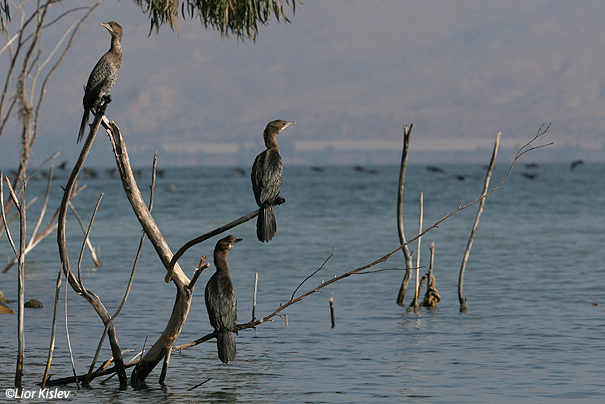
This small, dark waterbird feeds on fish it hunts by chasing underwater. Up to the mid-20th century, the pygmy cormorant was a common breeder in the Hula Valley and Israel’s northern valleys and thousands of birds from Eastern Europe and Turkey wintered in the country. The drainage of the Hula Marshes, and most of the other marshes in Israel, as well as other marshes in the Middle East, along with the establishment of fishponds, created a serious conflict that eventually led to the extinction of the pygmy cormorant in Israel. The fish farmers persecuted the cormorants and burned their nesting colonies, and for about 40 years, they did not breed in Israel. During the 1980s, the number of wintering pygmy cormorants in Israel began to increase gradually and in the early 1990s, birds were observed summering in Israel and a number of nesting attempts were made. The breeding population increased rapidly, particularly along the Jordan and Bet She’an valleys, and once again, there were severe conflicts between the cormorants and the fish farmers whose harvests were damaged. The Israel Nature and Parks Authority worked together with the fish farmers to implement a compromise solution – the pygmy cormorants were chased out of the valleys towards Lake Kinneret, where they can feed without causing serious harm. The solution proved to be successful and the cormorants moved their major breeding colonies to Lake Kinneret. In recent years over 1,000 cormorants breed on Lake Kinneret and have also established smaller breeding colonies in the Hula and Zevulun valleys and on the Carmel coast.
Kentish Plover Charadrius alexandrinus and Little Ringed Plover Charadrius dubius – Evidence for intensive exploitation of coastal areas and damage to stream banks
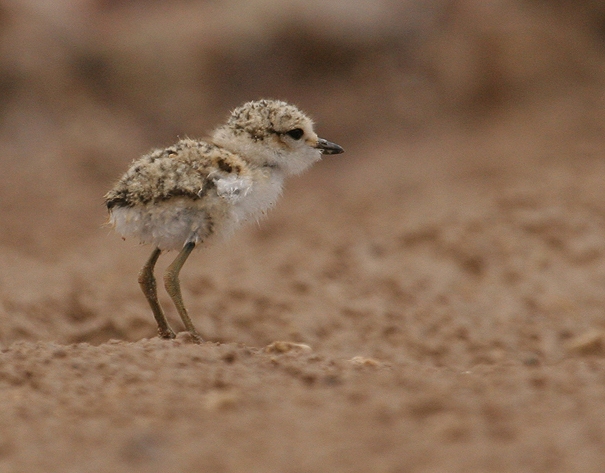
These two small, long-legged, short-billed waders feed on invertebrates and gather on sandy beaches and along muddy banks. Both species once nested in the hundreds along Israel’s Mediterranean coast and along the streams on Israel’s coast, northern valleys and the Jordan Valley. When the State of Israel was established, inhabitants enjoyed an average of 30 cm of coastline per person, which today has decreased to a mere two centimeters. This fact has a far-reaching negative effect on the animals that once inhabited our coastal areas. The animals were harmed both directly by humans and by the accumulation of trash and pollutants that led to the increase of invasive and eruptive species, such as the Hooded Crow, Egyptian mongoose and domestic cat (that increase the predation pressure on waders and other ground-nesting species). Furthermore, during the two decades following the establishment of the state, most of Israel’s streams were engineered and straightened, so that dirt roads and agricultural areas extend up to the stream banks. The Kentish and Little Ringed Plovers disappeared from Israel’s shores and streams over a very short period, from the mid-1970s to the early 1990s, and only small populations survived along the northern Dead Sea shores. A small number of Kentish Plovers occupied artificial habitats such as the saltpans in Eilat, but the Little Ringed Plover has not yet adopted alternative habitats and has almost completely disappeared from our landscapes as a breeding species.
Scrubland Species
This group (21 species) inhabits areas with characteristic sparse low shrubby or herbaceous vegetation and is a specialized group of species found in relatively arid, exposed areas. It is very sensitive to development and changes, such as tree plantings and road building, and requires extensive, continuous scrubland to survive. Over the years, these regions were not sufficiently protected and preserved and have been reduced by agricultural expansion, plantings and afforestation. At the same time, goat grazing, that has shaped and characterized most of Israel’s Mediterranean region, ceased after the plant protection law (the “black goat” law, 1950) was passed. Consequently, this group was severely affected and many of the species in it are now in danger of extinction. The distribution maps (Figure 14) show the areas where the scrubland specialists are still relatively numerous, including the Golan Heights, the Eastern Galilee and the Judean Lowlands. The sharpest decline in species diversity in this group occurred in the Western Galilee, the Carmel, the Menashe Plateau and Western Samaria. In the Jerusalem Mountains and the Northern Negev the trend is mixed – some species have disappeared (e.g. Tawny Pipit Anthus campestris, Calandra Lark Melanocorypha calandra and Black-headed Bunting Emberiza melanocephala), whereas others have expanded their range, such as the Lesser Kestrel Falco naumanni and the Woodlark Lullula arborea. In the southern Negev and the Arava, distribution maps indicate stability and even an increase in species richness. This may be related to expanding ranges due to expanding agriculture (e.g. the case of Rufous-tailed Scrub-robin Cercotrichas galactotes), or to the increase in sampling effort and the level of available information (as in the case of the Spectacled Warbler Sylvia conspicillata).
Number of Species
Figure 14: Threatened and near-threatened bird species that breed in open shrublands (Batha).
Decreased Distribution
Species listIncreased Distribution
Species listTawny Pipit Anthus campestris – a critically endangered migrating species
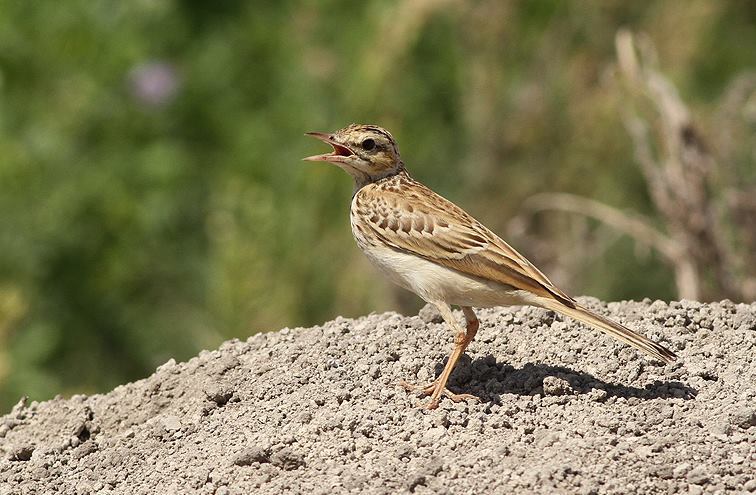
From the early 20th century, it was described as a common breeding species in northern and central Israel; up until the late 1980s, it nested on the slopes of Mt. Hermon from Mt. Kna’an in the north and down south to the Hebron Mountains. For the past two decades, it has been observed breeding almost exclusively on Mt. Hermon and there too its population has decreased to only about ten pairs. The Tawny Pipit is a migrant species and the sharp decline in its numbers could be related to the destruction of its habitats in Israel due to development and building on the peaks of Judea and Samaria, as well as to factors in its wintering areas in Africa and along its migration route. The Tawny Pipit is an example of a scrubland species that migrates to and overwinters in Africa. As a rule, all the populations of all the migrant scrubland species (that are summer breeders in Israel) have declined seriously. These include the Black-eared Wheatear Oenanthe hispanica, Black-headed Bunting Emberiza melanocephala, Cretzschmar's Bunting Emberiza caesia, Bimaculated Lark Melanocorypha bimaculata, Calandra Lark Melanocorypha calandra, Upcher's Warbler Hippolais languida, Rufous-tailed Scrub-robin Cercotrichas galactotes and others.
Long-billed Pipit Anthus similis – a vulnerable resident species
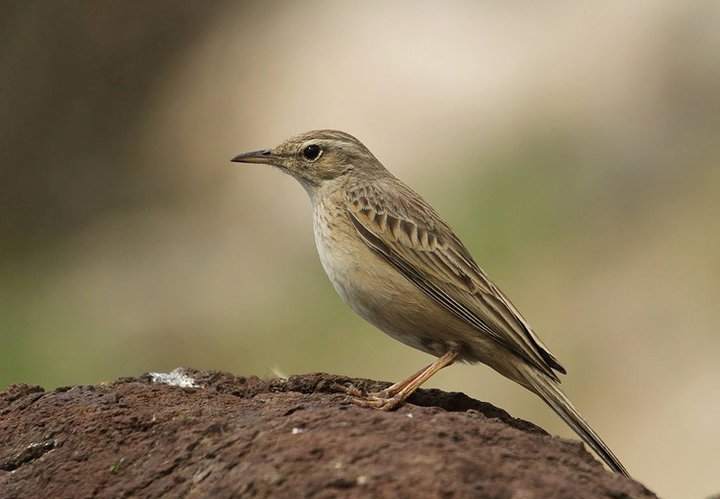
The long-billed Pipit is one of the prominent representatives of the scrubland species. It occupies most of the scrubland areas in Israel, from the Galilee and Golan Heights in the north down to the desert transition scrublands in the Northern Negev and the slopes of the Hebron Mountains. Unlike the Tawny Pipit that once inhabited mountaintops, the long-billed pipit prefers lower altitudes, occasionally even the lower third of mountain slopes. As its Hebrew name (mountain pipit) implies, its habitat is always associated with steep rocky slopes. During the past decades, it was seriously affected by habitat fragmentation and deterioration because of development – construction, roadbuilding and planting. In northern Israel, it has receded from areas where the Mediterranean woodlands have matured and closed up because of the cessation of grazing (and the “black goat” law). In Judea and Samaria there has not been much planting, and grazing in the region is intensive (frequently too intensive, leading to overgrazing), and consequently the long-billed pipit is flourishing and is one of the most common birds on the slopes of the Judean and Samarian mountains, particularly east of the water divide. The fact that it is a resident species has apparently saved it from the harsher fate of its migrating relatives.
Species of Open Desert Flats
This group includes 26 species that occupy open landscapes in the desert, such as the sandy, loess and hamada flats. The threatened flagship species in this group are the Asian Houbara Chlamydotis macqueeni, the Cream-colored Courser Cursorius cursor, the sandgrouse species and unique larks such as the Greater Hoopoe-lark Alaemon alaudipes and Temminck’s Lark Eremophila bilopha. The distribution maps (Figure 15) show that the main concentration of these species is in the Western Negev (sandy areas in the region and Pit’hat Nitsana) and in the interior wadis in the southern Negev and the Meishar. The most significant decline in the ranges of species in this group has been recorded in the northeastern Negev and along the Arava (the decline of the three sandgrouse species, the Asian Houbara, Cream-colored Courser, the Greater Hoopoe-lark and others), the Jordan Valley and the Golan Heights (the Isabelline Wheatear Oenanthe isabellina, Pin-tailed Sandgrouse Pterocles alchata, Cream-colored Courser). The apparent increase in the number of species in the central and southern Negev is probably related to the increasing number of birders visiting these areas and to the extensive surveys conducted by the SPNI’s Ornithological Center.
Number of Species
Figure 15: Threatened and near-threatened bird species that breed in open desert flats.
Decreased Distribution
Species listIncreased Distribution
Species listMountainous Desert Species
This group includes 26 species that inhabit rocky areas and cliffs in the desert. Some of the prominent species include the Sinai Rosefinch Carpodacus synoicus, Desert Finch Rhodospiza obsoleta, Striolated Bunting Emberiza striolata, various wheatear species, owls such as the Desert Tawny Owl Strix hadorami, Pharaoh Eagle-owl Bubo ascalaphus and diurnal raptors such as the Sooty Falcon Falco concolor and Barbary Falcon Falco pelegrinoides. Whereas most of the representatives of this group now inhabit cliff habitats in the southern Judean Desert and the eastern Negev (Figure 16), the sharpest declines were recorded in eastern Samaria and the western Negev Highlands. The cliff habitats in eastern Samaria suffer from overgrazing by sheep herds that inhabit the caves in and above the cliffs, including within the boundaries of declared nature reserves. The shepherds and their flocks create disturbances that interfere with nesting efforts of many of the species as well as depleting available food resources.
Number of Species
Figure 16: Threatened and near-threatened bird species that breed in mountainous deserts.
Decreased Distribution
Species listIncreased Distribution
Species listSpecies Unique to Mt. Hermon
Mt. Hermon, in addition to being the highest mountain in Israel (2,200 m on the Israeli side, 2,814 m in Syria) also has diverse landscapes and natural ecosystems not found in any other part of Israel. The short transition from the mountain base to its summit crosses a number of zoogeographical zones – from Mediterranean woodland, through the Irano-Turanian steppe zone and up to the alpine zone at the mountain summit, which is above the tree line. Mt. Hermon is the landscape unit with the highest breeding bird diversity in Israel with 84 avian species breeding there, of which, in Israel, 18 breed only on Mt. Hermon. These unique species reach the southern limit of their global range at the Israeli side of the Hermon. They are represented by extremely small populations due to the limited area of suitable habitat. Species such as the Rufous-tailed Rock Thrush Monticola saxatilis, Finsch's Wheatear Oenanthe finschii, Eurasian Crag Martin Ptyonoprogne rupestris and the Ortolan Bunting Emberiza hortulana breed on the Hermon, with a maximum of ten pairs per species.
The authors of the red book were faced with a dilemma of how to approach these edge populations, most of which have always been extremely small in Israel, although this does not attest to their extinction threat in our region (mainly because, across the border, in the mountains of Syria and Lebanon, there are larger populations). In the previous edition of the red book (2002), these species were only categorized as endangered if a significant decrease in their population had been recorded. Consequently, most of them were categorized as LC or NT.
In this edition, it was decided to apply regional adaptations regarding species that are at the edge of their global range in Israel, so that the assessment process could be transparent and repeatable and correctly express the risk of extinction facing the species in Israel.
Regional Adaptation l2 – species at the edge of their global range. This adaptation is meant to reflect the reduced extinction threat to species whose population in Israel is a marginal population and a negligible portion of the global population (and therefore the species has always bred here in small numbers, like most of the species unique to Mt. Hermon). These species were assigned a high threat level (CR/EN) during the first assessment stage that is based on the global IUCN criteria.
Table 5. Regional Adaptation – l2 – species at the edge of their global range.
|
Condition |
Application |
|---|---|
|
The Israeli population is a negligible portion (below 1%) of the specific species or subspecies population |
Reduction of two threat levels |
|
The Israeli population is a significant portion (above 1%) of the specific species or subspecies population |
Reduction of one threat level |
|
A significant reduction in the numbers or area of occupancy of the Israeli population (20% or more over 10 years) has been observed |
No change in the threat level determined in the previous stage |
The results of applying these regional adaptations was that the Mt. Hermon species were assigned different categories than in the previous edition. Some of these changes are a result of differences in methods, but some result from changes in the population status according to data collected in recent years, e.g. the Hermon breeding bird census conducted in 2013, 2014 (Israeli and Perlman 2013).
Table 6. Species unique to Mt. Hermon, ranked in descending order of threat level.
|
|
Species |
New threat category |
Previous threat category |
Assessment of the real change in the population status |
|---|---|---|---|---|
|
1 |
Bimaculated Lark Melanocorypha bimaculata |
RE |
CR |
decline |
|
2 |
Tawny Pipit Anthus campestris |
CR |
EN |
decline |
|
3 |
Syrian Serin Serinus syriacus |
VU |
NT |
decline |
|
4 |
Ortolan Bunting Emberiza hortulana |
VU |
LC |
unchanged |
|
5 |
Finsch's Wheatear Oenanthe finschii |
VU |
LC |
unchanged |
|
6 |
Rufous-tailed Rock Thrush Monticola saxatilis |
VU |
NT |
decline |
|
7 |
Horned Lark Eremophila alpestris |
VU |
NT |
unknown |
|
8 |
White-throated Robin Irania gutturalis |
VU |
NT |
unchanged |
|
9 |
Eurasian Crag Martin Ptyonoprogne rupestris |
VU |
LC |
unchanged |
|
10 |
Red-backed Shrike Lanius collurio |
VU |
NT |
decline |
|
11 |
Common Chiffchaff Phylloscopus collybita |
VU |
NA |
unknown |
|
12 |
Eurasian Crimson-winged Finch Rhodopechys sanguineus |
NT |
NT |
unchanged |
|
13 |
Western Rock Nuthatch Sitta neumayer |
NT |
NT |
unchanged |
|
14 |
Rock Bunting Emberiza cia |
NT |
LC |
unchanged |
|
15 |
Black Redstart Phoenicurus ochruros |
NT |
LC |
unchanged |
|
16 |
Eastern Bonelli’s Warbler Phylloscopus orientalis |
NT |
LC |
decline |
|
17 |
Sombre Tit Poecile lugubris |
NT |
LC |
unknown |
|
18 |
Northern Wheatear Oenanthe oenanthe |
LC |
NT |
unchanged |
In conclusion, the new assessment of the Mt. Hermon species totals one regionally extinct (RE) species, 10 threatened species (VU, CR) and 7 near threatened or least concerned species (NT, LC). One species, the Syrian Serin, is both regionally and globally endangered.
These results emphasize the importance of Mt. Hermon to the biodiversity of Israel’s birds. Despite the uniqueness of Mt. Hermon’s natural resources and despite the fact that considerable portions of it have been declared nature reserves, no real attention has been paid to the conservation of this unique bird population. Katef Hermon has been subject to extensive development, tourist and economic pressure during recent decades. This activity, which includes building, fencing, roads and soil exposure is conducted on the mountain summit by the Israel Defense Forces (IDF) and the Hermon Ski Resort. The lower mountain zones are extremely impacted by intensive grazing, planting and building on the part of the settlements at the foot of the mountain. All these activities have far-reaching effects on the natural environment on Mt. Hermon and require regulation in the framework of a specific conservation program.
Globally Endangered Bird Species
Forty-one bird species that spend at least part of their annual life cycle in Israel are categorized at various levels of global threat. Most of these species are passage migrants, wintering birds or accidentals and nine species also have breeding populations in Israel.
|
Table 7. Globally endangered birds observed in Israel, according to their global threat category. |
|||||
|---|---|---|---|---|---|
|
|
CR |
EN |
VU |
NT |
Total |
|
Number of species |
3 |
6 |
13 |
19 |
41 |
|
Table 8. Globally threatened and near threatened species that breed (or bred previously) in Israel. |
|||||
|---|---|---|---|---|---|
|
Species |
Scientific name |
Global threat |
Threat in Israel |
Estimated annual numbers |
Status in Israel |
|
White-headed Duck |
Oxyura leucocephala |
EN |
CR |
1,000-3,000 |
Relatively common winter visitor; very rare breeder |
|
Egyptian Vulture |
Neophron percnopterus |
EN |
CR |
hundreds |
Passes over in small numbers and rare summer breeder |
|
Basra Reed -warbler |
Acrocephalus griseldis |
EN |
NA |
few |
Extremely rare vagrant and intermittent breeder |
|
Lappet-faced Vulture |
Torgos tracheliotos |
EN |
RE |
0 |
Extinct as a breeder; extremely rare vagrant |
|
Marbled Teal |
Marmaronetta angustirostris |
VU |
EN |
tens |
Rare resident breeder |
|
Asian Houbara |
Chlamydotis macqueeni |
VU |
EN |
hundreds |
Rare resident breeder |
|
European Turtle-dove |
Streptopelia turtur |
VU |
NT |
thousands |
Passage migrant and common summer breeder |
|
Syrian Serin |
Serinus syriacus |
VU |
VU |
hundreds |
Breeds on Mt. Hermon; overwinters in the Negev |
|
Sooty Falcon |
Falco concolor |
VU |
NT |
hundreds |
Summer breeder |
|
Ferruginous Duck |
Aythya nyroca |
NT |
EN |
Tens-hundreds |
Rare resident breeder; small numbers overwinter |
|
Bearded Vulture |
Gypaetus barbatus |
NT |
RE |
0-1 |
Extinct as a breeder; extremely rare vagrant |
|
Cinereous Vulture |
Aegypius monachus |
NT |
RE |
2-8 |
Extinct as a breeder; rare winter visitor |
Globally Endangered Species Meriting Special Mention
A number of species categorized as globally endangered are observed in Israel in relatively significant numbers:
lior2.jpg)
Sociable Lapwing Vanellus gregarius – classified as critically endangered (CR) is seen in Israel in small numbers during migration and in winter.
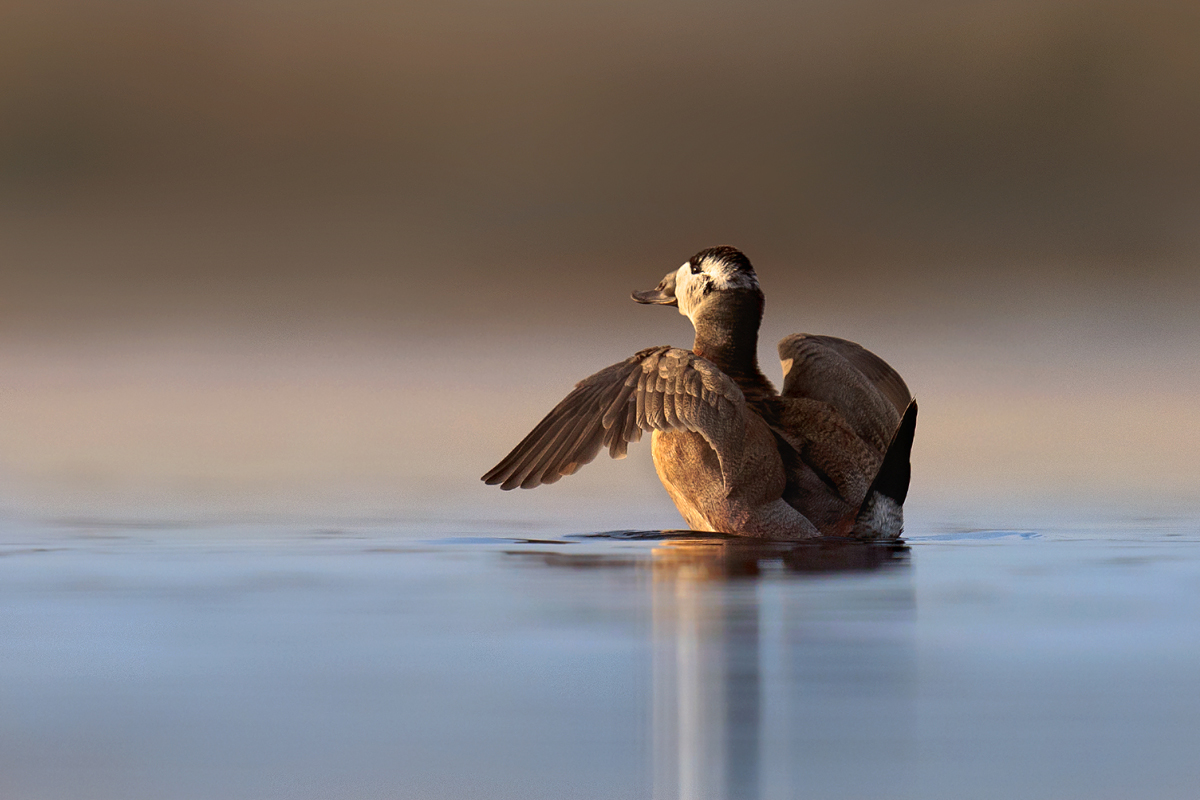
White-headed Duck Oxyura leucocephala – classified as endangered (EN) with about 10% of its global population wintering in Israel. Found nesting in Israel in summer 2017, after being absent as a breeder for about 100 years.
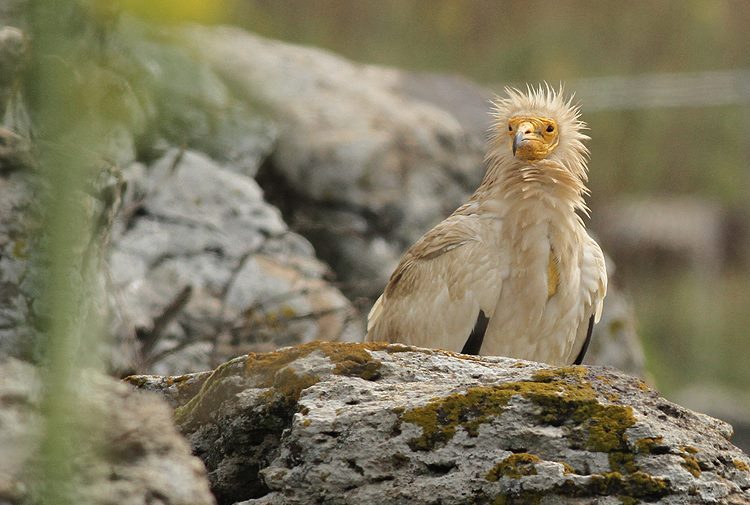
Egyptian Vulture Neophron percnopterus – a vulture species classified as endangered (EN); several tens of pairs breed in Israel. Has been severely affected by poisoning and electrocution.
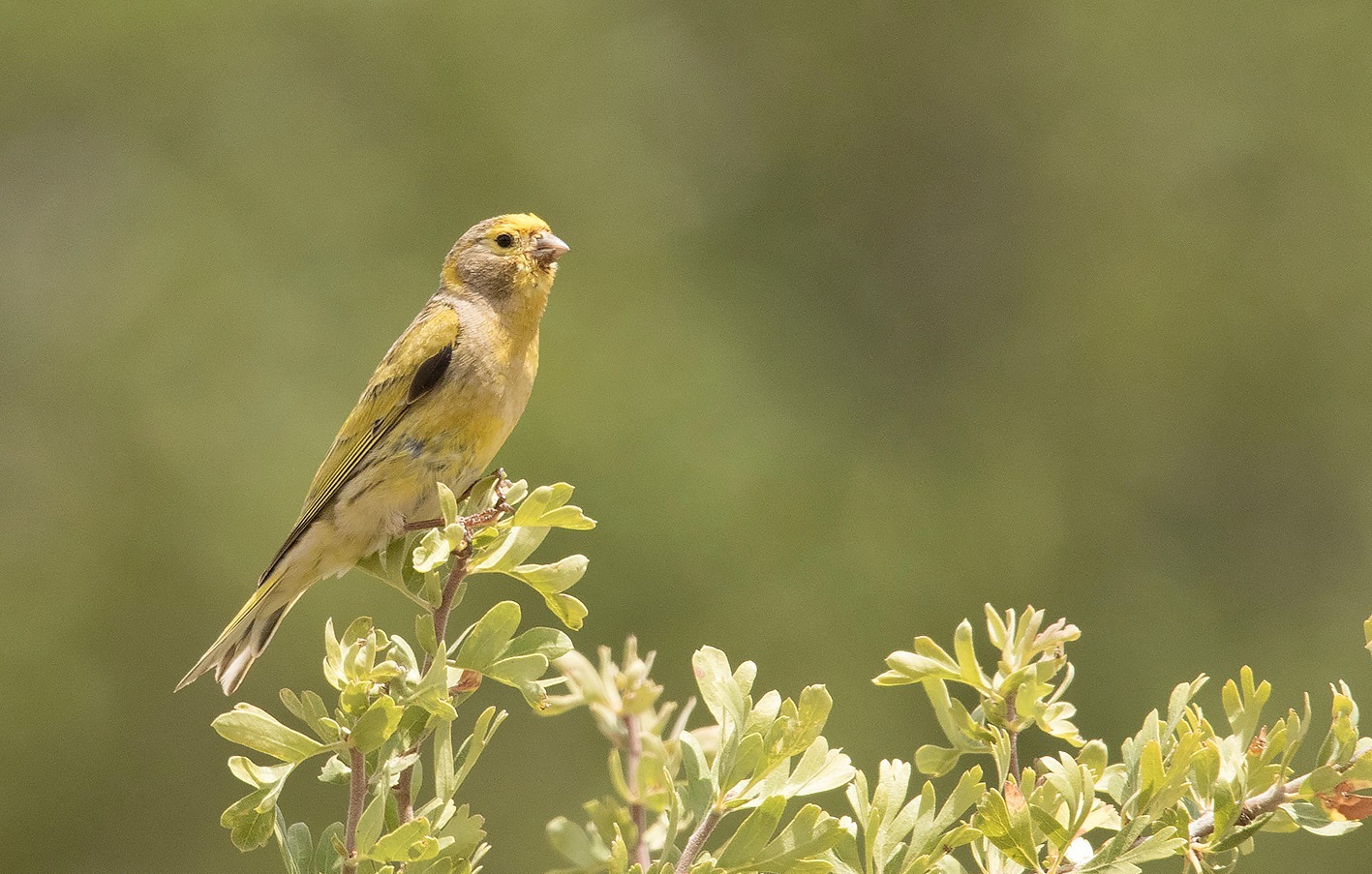
Syrian Serin Serinus syriacus – classified as vulnerable (VU). This beautiful songbird is endemic to our region (Mount Lebanon, Syria and Jordan). Some 100-150 pairs breed on Katef Hermon, and they comprise a significant portion of the global population.
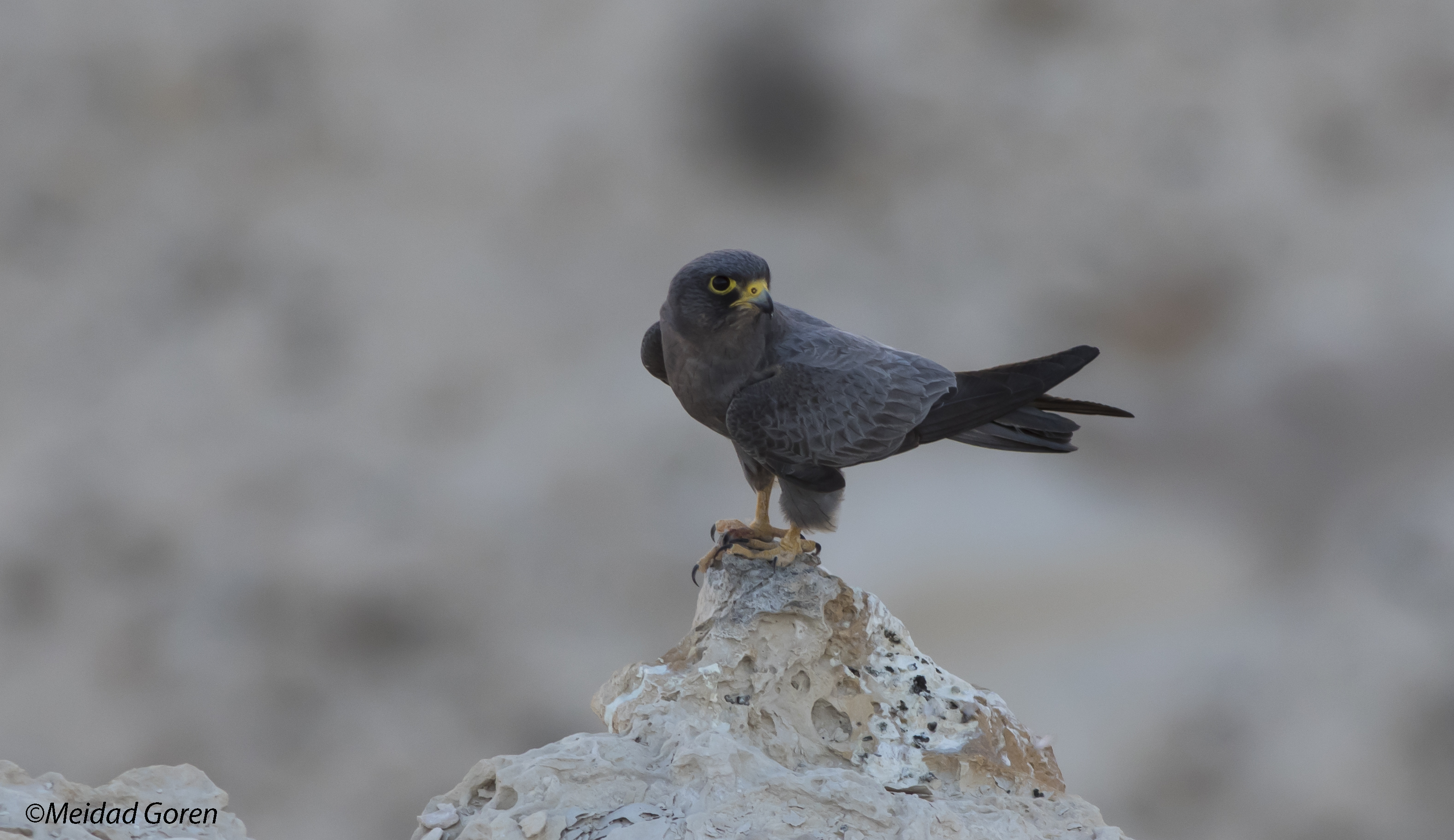
Sooty Falcon Falco concolor – classified as vulnerable (VU). A small raptor with a limited global range. The population in Israel numbers about 100 nesting pairs, out of a global population of 2,800 to 4,000 individuals.
Appendix: Threat Categories of Breeding Bird Species in Israel and Changes Compared to the Previous Risk Assessment
|
Species |
Scientific name |
New Threat Category |
Previous Threat Category |
Change |
|---|---|---|---|---|
|
Grey Heron |
Ardea cinerea |
RE |
RE |
Unchanged |
|
Black Kite |
Milvus migrans |
RE |
RE |
Unchanged |
|
Marsh Harrier |
Circus aeruginosus |
RE |
RE |
Unchanged |
|
Arabian Ostrich |
Struthio camelus syriacus |
RE |
RE |
Unchanged |
|
Black Tern |
Chlidonias niger |
RE |
RE |
Unchanged |
|
Cinereous Vulture |
Aegypius monachus |
RE |
RE |
Unchanged |
|
Lappet-faced Vulture |
Torgos tracheliotus |
RE |
RE |
Unchanged |
|
Lesser Spotted Eagle |
Aquila pomarina |
RE |
RE |
Unchanged |
|
Verreaux's Eagle |
Aquila verreauxii |
RE |
RE |
Unchanged |
|
Bearded Vulture |
Gypaetus barbatus |
RE |
RE |
Unchanged |
|
Brown Fish-owl |
Ketupa zeylonensis |
RE |
RE |
Unchanged |
|
Savi's Warbler |
Locustella luscinioides |
RE |
CR |
Decline |
|
Pied Avocet |
Recurvirostra avosetta |
RE |
NT |
Decline |
|
Bimaculated Lark |
Melanocorypha bimaculata |
RE |
CR |
Decline |
|
Species |
Scientific name |
New Threat Category |
Previous Threat Category |
Change |
|---|---|---|---|---|
|
Lanner Falcon |
Falco biarmicus |
CR |
VU |
Decline |
|
Short-eared Owl |
Asio flammeus |
CR |
DD |
Decline |
|
Griffon Vulture |
Gyps fulvus |
CR |
VU |
Decline |
|
Golden Eagle |
Aquila chrysaetos |
CR |
EN |
Decline |
|
Bonelli’s Eagle |
Aquila fasciata |
CR |
EN |
Decline |
|
Tawny Pipit |
Anthus campestris |
CR |
EN |
Decline |
|
Lichtenstein's Sandgrouse |
Pterocles lichtensteinii |
CR |
NT |
Decline |
|
Egyptian Vulture |
Neophron percnopterus |
CR |
VU |
Decline |
|
Olive-tree Warbler |
Hippolais olivetorum |
CR |
DD |
Decline |
|
Common Quail |
Coturnix coturnix |
CR |
NT |
Decline |
|
Blue-cheeked Bee-eater |
Merops persicus |
CR |
VU |
Decline |
|
Egyptian Nightjar |
Caprimulgus aegyptius |
CR |
DD |
Decline |
|
Greater Hoopoe-lark |
Alaemon alaudipes |
CR |
CR |
Unchanged |
|
Moustached Warbler |
Acrocephalus melanopogon |
CR |
CR |
Unchanged |
|
Little Ringed Plover |
Charadrius dubius |
CR |
CR |
Unchanged |
|
Arabian Warbler |
Sylvia leucomelaena |
CR |
CR |
Unchanged |
|
Great Reed-warbler |
Acrocephalus arundinaceus |
CR |
CR |
Unchanged |
|
Peregrine Falcon |
Falco peregrinus |
CR |
RE |
Improvement |
|
Great Crested Grebe |
Podiceps cristatus |
CR |
RE |
Improvement |
|
White-tailed Eagle |
Haliaeetus albicilla |
CR° |
RE |
Improvement |
|
White-headed Duck |
Oxyura leucocephala |
CR |
RE |
Improvement |
|
Species |
Scientific name |
New Threat Category |
Previous Threat Category |
Change |
|---|---|---|---|---|
|
Barbary Falcon |
Falco pelegrinoides |
EN |
NT |
Decline |
|
Eurasian Hobby |
Falco subbuteo |
EN |
NT |
Decline |
|
Black-headed Bunting |
Emberiza melanocephala |
EN |
VU |
Decline |
|
Asian Houbara |
Chlamydotis macqueeni |
EN |
VU |
Decline |
|
Black-eared Wheatear |
Oenanthe hispanica |
EN |
LC |
Decline |
|
Calandra Lark |
Melanocorypha calandra |
EN |
NT |
Decline |
|
Pin-tailed Sandgrouse |
Pterocles alchata |
EN |
NT |
Decline |
|
Spotted Sandgrouse |
Pterocles senegallus |
EN |
VU |
Decline |
|
Little Tern |
Sternula albifrons |
EN° |
NT |
Decline |
|
Marbled Teal |
Marmaronetta angustirostris |
EN |
CR |
Improvement |
|
Kentish Plover |
Charadrius alexandrinus |
EN |
CR |
Improvement |
|
Ferruginous Duck |
Aythya nyroca |
EN |
CR |
Improvement |
|
Collard Pratincole |
Glareola pratincola |
EN |
CR |
Improvement |
|
Species |
Scientific name |
New threat category |
Previous threat category |
Change |
|---|---|---|---|---|
|
White-throated Robin |
Irania gutturalis |
VU° |
NT |
Decline |
|
Purple Heron |
Ardea purpurea |
VU° |
NT |
Decline |
|
Syrian Serin |
Serinus syriacus |
VU° |
NT |
Decline |
|
Cretzschmar's Bunting |
Emberiza caesia |
VU |
NT |
Decline |
|
Ortolan Bunting |
Emberiza hortulana |
VU° |
LC |
Decline |
|
Golden Oriole |
Oriolus oriolus |
VU° |
NT |
Decline |
|
Spotted Flycatcher |
Muscicapa striata |
VU |
LC |
Decline |
|
Rufous-tailed Scrub-robin |
Erythropygia galactotes |
VU |
NT |
Decline |
|
Red-backed Shrike |
Lanius collurio |
VU |
NT |
Decline |
|
White Stork |
Ciconia ciconia |
VU° |
NT |
Decline |
|
European Roller |
Coracias garrulus |
VU |
NT |
Decline |
|
Pied Wagtail |
Motacilla alba |
VU° |
NT |
Decline |
|
Finsch's Wheatear |
Oenanthe finschii |
VU° |
LC |
Decline |
|
Isabelline Wheatear |
Oenanthe isabellina |
VU |
LC |
Decline |
|
Eurasian Crag Martin |
Hirundo rupestris |
VU° |
LC |
Decline |
|
Common Chiffchaff |
Phylloscopus collybita |
VU° |
NA |
Decline |
|
Lesser Short-toed Lark |
Alaudala rufescens |
VU |
LC |
Decline |
|
Short-toed Lark |
Calandrella brachydactyla |
VU |
DD |
Decline |
|
Rufous-tailed Rock Thrush |
Monticola saxatilis |
VU° |
NT |
Decline |
|
Horned Lark |
Eremophila alpestris |
VU° |
NT |
Decline |
|
Common Tern |
Sterna hirundo |
VU° |
NT |
Decline |
|
Upcher’s Warbler |
Hippolais languida |
VU |
NT |
Decline |
|
Spectacled Warbler |
Sylvia conspicillata |
VU |
VU |
Unchanged |
|
Little Swift |
Apus affinis |
VU |
VU |
Unchanged |
|
Temminck’s Lark |
Eremophila bilopha |
VU° |
VU |
Unchanged |
|
Cream-colored Courser |
Cursorius cursor |
VU |
VU |
Unchanged |
|
European Bee-eater |
Merops apiaster |
VU |
VU |
Unchanged |
|
Yellow Wagtail |
Motacilla flava |
VU° |
CR |
Improvement |
|
Long-billed Pipit |
Anthus similis |
VU |
EN |
Improvement |
|
Crowned Sandgrouse |
Pterocles coronatus |
VU° |
EN |
Improvement |
|
Nubian Nightjar |
Caprimulgus nubicus |
VU° |
CR |
Improvement |
References
Eshbol, Y. 1999. A nest for an avocet. Eretz VeTeva 64: 21-27 (In Hebrew).
Inbar, R. 1971-1982. Birds of Israel (4 vols.). Yavneh (In Hebrew).
Frumkin, R. and Man, S. 1984. Breeding raptors in Israel’s desert region. The Torgos, vol. 11. The Society for the Protection of Nature in Israel (In Hebrew).
Leshem, Y. 1979. Raptors in Israel. The Society for the Protection of Nature in Israel. (In Hebrew, English summary).
Mayrose, A. and Alon, D. 2002. Birds, chapter in: The Red Book of Vertebrates in Israel, Dolev and Perevolotsky (eds.). The Israel Nature and Parks Authority and the Society for Protection of Nature in Israel, Tel Aviv, Israel.
Mendelssohn, H. 1972. The impact of pesticides on bird life in Israel. ICBP 11:75-104.
Mendelssohn, H. 1975. Report on the Status of Some Bird Species in Israel in 1974. I.C.B.P. 12:265-270.
Milner-Gulland, E.J., E. Kreuzberg-Mukhina, B. Grebot, S. Ling, E. Bykova, I. Abdusalamov, A. Bekenov, U. Gärdenfors, C. Hilton-Taylor, V. Salnikov, L. Stogova, 2006. Application of IUCN red listing criteria at the regional and national levels: A case study from Central Asia. Biodiversity and Conservation 15 (6): 1873-1886.
Paz, U. Birds. In: Alon, A. (ed.) Plants and animals of the Land of Israel. Vol. 6. The Publishing House, Ministry of Defense and the Society for the Protection of Nature in Israel, Israel (In Hebrew).
Porter, R.F., Christensen, S., and Schiermacker-Hansen, P., 1996. Field Guide to the Birds of the Middle East. T and A D Poyser LTD, London.
Tristram, H.B. 1867 (new edition 1975). Land of Israel. A Journey of Travel in Palestine. Diary 1853-1864. Hebrew Edition, Mossad Bialik.
Shirihai, H., 1996. The Birds of Israel. Academic Press, London.
Shochat, E. 2000. Bird species diversity in the Negev: effects of scrub fragmentation by planted forests. Ph.D. Thesis, Ben-Gurion University (In Hebrew, English summary).
Shulman, Y. 2001. The ecology of the lesser kestrel in Israel. M.Sc. Thesis, Tel Aviv University, Israel (In Hebrew).


